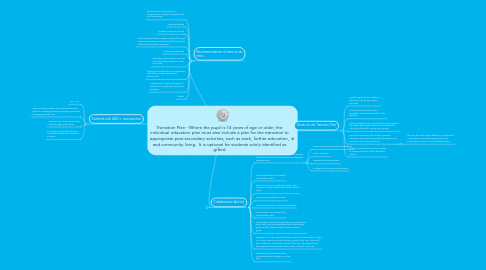Transition Plan - Where the pupil is 14 years of age or older, the individual education plan must also include a plan for the transition to appropriate post secondary activities, such as work, further education, and community living. It is optional for students solely identified as gifted
Door Laurel Mouland


1. Goals on the Transtion Plan
1.1. Specific goals for the student's transition to post secondary activities
1.2. realistic and must reflect the strengths, needs and interests of the student
1.3. actions required now and in the future to achieve the stated goals again based on the student's identified strengths, needs and interests
1.4. Persons or agencies (the student, parents, educators, providers of specialized support and services, community agencies)
1.4.1. they are the ones responsible for or involved in completing or providing assistance in the completion of each of the identified actions
1.5. realistic timelines need to be in place to implement each of the identified actions
2. Students with ASD = new practice
2.1. PPM 140
2.2. Same as other except can also have transition plan for changing buildings, changing activities, changing teachers, etc.
2.3. relevant ABA methods must be used to support transition
2.4. including professionals that are currently working with student in process
3. Collaborative Activity
3.1. Important to have communication from teacher to teacher to provide continuity in the student's programming
3.1.1. share successful instructional strategies
3.1.2. share resources
3.1.3. required accommodations
3.1.4. strategies for managing behaviours
